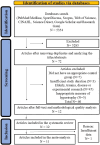The impact of resistance training on gluteus maximus hypertrophy: a systematic review and meta-analysis
- PMID: 40276368
- PMCID: PMC12018462
- DOI: 10.3389/fphys.2025.1542334
The impact of resistance training on gluteus maximus hypertrophy: a systematic review and meta-analysis
Abstract
This systematic review aims to examine and synthesize the existing literature regarding gluteus maximus (GMax) hypertrophy as a result of dynamic exercises that incorporate hip extension with external resistance. A comprehensive search was undertaken across the following databases: PubMed/Medline, SportDiscuss, Scopus, Web of Science, CINAHL, Science Direct, Google Scholar, and ResearchGate. Twelve articles met the established inclusion criteria, leading to the subsequent key findings: 1) resistance training exhibits a moderate effect on GMax hypertrophy (11 studies, SMD 0.71, 95% CI [0.50, 0.91], p < 0.00001, I2 = 22%); 2) subgroup analyses of single (seven studies, SMD 0.74, 95% CI [0.36, 1.13], p = 0.0001, I2 = 52%) and combined (six studies, SMD 0.68, 95% CI [0.44, 0.92], p < 0.00001, I2 = 0%) training protocols have demonstrated moderate effects; 3) when emphasizing GMax hypertrophy at the expense of other muscle groups, single exercises, such as the barbell hip thrust, should be prioritized; 4) back squats performed in parallel or full range of motion significantly enhance GMax hypertrophy; 5) leg press machines and kneeling hip extensions can also facilitate increased GMax hypertrophy; 6) training programs that incorporate combined hip extension exercises, whether single-joint or multi-joint, significantly promote an increase in GMax hypertrophy. This study concludes that a variety of exercises-whether focused on a specific joint (single-joint) or encompassing multiple joints (multi-joint)-can effectively stimulate GMax hypertrophy, whether executed individually or in combination.
Keywords: exercise; hip; muscle mass; resistance training; skeletal muscle.
Copyright © 2025 Krause Neto, Krause and Gama.
Conflict of interest statement
The authors declare that the research was conducted in the absence of any commercial or financial relationships that could be construed as a potential conflict of interest.
Figures







References
-
- Andersen V., Fimland M. S., Mo D. A., Iversen V. M., Vederhus T., Rockland Hellebø L. R., et al. (2018). Electromyographic comparison of barbell deadlift, hex bar deadlift, and hip thrust exercises: a cross-over study. J. Strength Cond. Res. 32 (3), 587–593. 10.1519/JSC.0000000000001826 - DOI - PubMed
-
- Balshaw T. G., Funnell M. P., McDermott E., Maden-Wilkinson T. M., Abela S., Quteishat B., et al. (2023). The effect of specific bioactive collagen peptides on function and muscle remodeling during human resistance training. Acta Physiol. (Oxf). 237(2):e13903. 10.1111/apha.13903 - DOI - PMC - PubMed
Publication types
LinkOut - more resources
Full Text Sources
Miscellaneous

